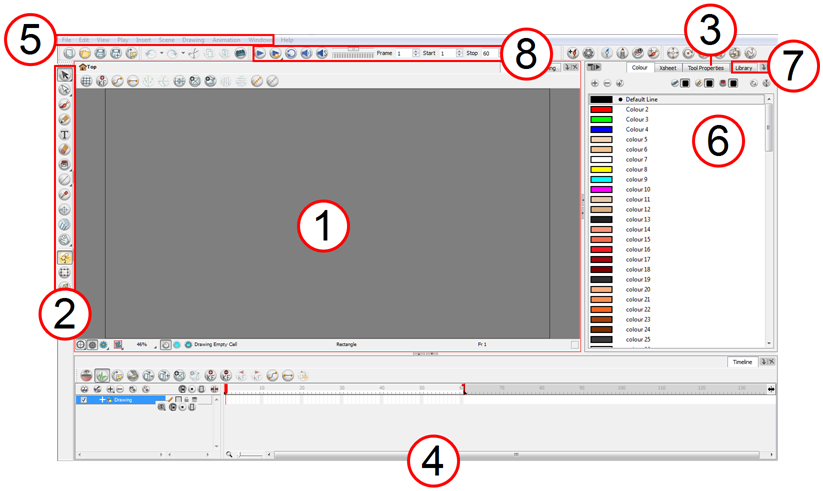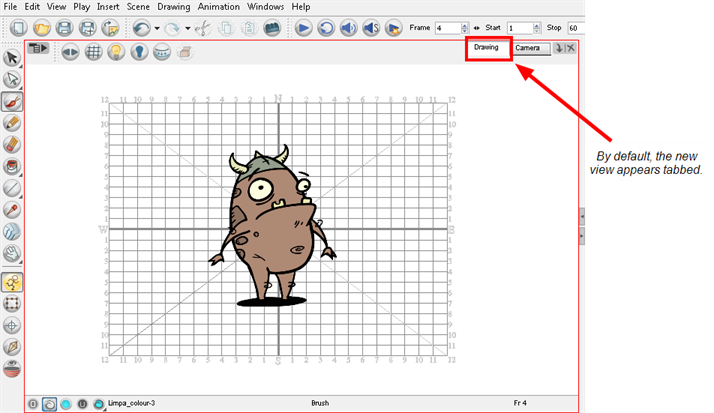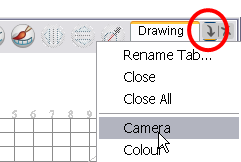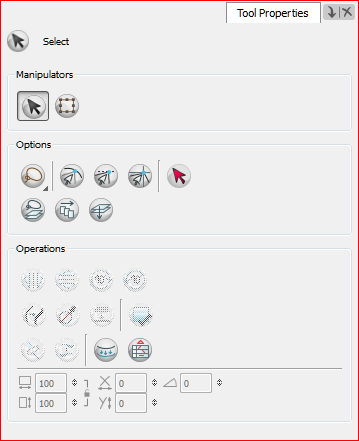Interface
It’s important that you become familiar with the following elements of the user interface, this will help you to start using Toon Boom Animate. You can learn more about the highlights described here, and how to use them in a production context, throughout this guide.
When you start Toon Boom Animate for the first time, the default workspace is displayed. It contains all of the main elements you need to use.

Adding a View
To add a view:
|
1.
|
Select the view you want to add from Windows > The desired view. |


You can also use the Window drop-down menu button included in each view already available in the workspace. Click on the button and select a view from the list. You can only open one instance of the same view. In other words, you cannot have two Camera views open at the same time.
You can open several instances of the same view except for the Timeline, Tool Properties, Colour and Drawing views.
|
2.
|
To dock a floating window in your workspace, drag the window’s tab onto one of the workspace’s views. |

Tool Properties View

The contextual Tool Properties view contains the most common options and operations related to the currently selected tool. As soon as you select a tool from the Tools toolbar, the Tool Properties view will be updated.
For example, if you choose the Select  tool in the Tools toolbar, the Tool Properties view will display the options and operations related to the Select tool such as Snap to Contour, Apply to All Drawings, Flip Horizontal and Flatten.
tool in the Tools toolbar, the Tool Properties view will display the options and operations related to the Select tool such as Snap to Contour, Apply to All Drawings, Flip Horizontal and Flatten.
Interface Navigation
Toon Boom Animate supports zoom in, zoom out, rotate, pan and reset view position for easy interface navigation.
|
•
|
Zoom In: Zooms into the view. From the top menu, select View > Zoom In or press [2]. |
|
•
|
Zoom Out: Zooms out of the view. From the top menu, select View > Zoom Out or press [1]. |
|
•
|
To zoom in and zoom out, hold down [Spacebar] and your middle mouse button while moving the mouse up or down. |
|
•
|
To pan the view, hold down the keyboard shortcut [Spacebar] and drag your mouse in the direction you want to pan the view. |
|
•
|
To Recentre the view: recentres the view on your mouse cursor or press [N]. |
|
•
|
Reset View: Resets the view to its default position. From the top menu, select View > Reset View or press [Shift] + [M]. |
|
•
|
Reset Rotation: Resets the view’s rotation to its default position. From the top menu, select View > Reset Rotationor press [Shift] + [X]. |
|
•
|
Reset Pan: Resets the view’s pan to its default position. From the top menu, select View > Reset Pan or press [Shift] + [N]. |
|
•
|
Reset Zoom: Resets the view’s zoom to its default position. From the top menu, select View > Reset Zoom. |
|
•
|
Toggle Full Screen: Enlarges the selected view to full screen. The full screen process is done in three stages. From the top menu, select View > Toggle Full Screen or press [Ctrl] + [F] (Windows) or [⌘] + [F] (Mac OS X).
|
|
•
|
First, the selected view enlarges to the maximum width or height, but keeps the tool views such as Colour or Tool Properties view. |
|
•
|
Second, the view enlarges to full screen. |
|
•
|
Third, the view returns to its original size. |
|
•
|
Rotate 90 CW: Rotates the Camera view 90 degrees clockwise, like an animation table. From the top menu, select View > Rotate View CW. |
|
•
|
Rotate 90 CCW: Rotates the Camera view 90 degrees counter-clockwise, like an animation table. From the top menu, select View > Rotate View CCW. |
If you're using a tablet or trackpad that supports touch, then you can also use standard two-finger gestures for zoom, rotate, and pan of the canvas.





![]() tool in the Tools toolbar, the Tool Properties view will display the options and operations related to the Select tool such as Snap to Contour, Apply to All Drawings, Flip Horizontal and Flatten.
tool in the Tools toolbar, the Tool Properties view will display the options and operations related to the Select tool such as Snap to Contour, Apply to All Drawings, Flip Horizontal and Flatten.